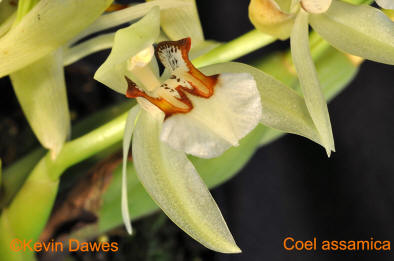My pod parent, Coel speciosa spp. incarnata. was labeled Coel speciosa but one 'expert' suggested that it might be Speciosa salmonicolor. As the flower matures and the colour fades/changes it indeed adopts an attractive pale salmon colour. This has been confusing because the RHS has a formally registered species, Coelogyne salmonicolor. Many sources sell a plant labeled as Coelogyne speciosa var Salmonicolor or as Coelogyne speciosa 'Salmonicolor'. However, Coel speciosa has a huge range of colour variations and a couple of formally recognised variations with two now formally recognised as sub-species.
I have made a couple of hybrids using this attractive form but after many long discussions and lots of research, I am convinced that my plant is Coel speciosa sub-species incarnata
My flower is much too large to be Coel salmonicolor, which is much smaller than Coel speciosa. Mine has two very large and broad keels which are heavily adorned with hairs and then platelets near the end, as well as a small third keel. In addition, the frontal lobe has significant fimbriation - all indicating that it is Coel speciosa.
When I pollinated this hybrid in May 2009 I visualised the salmon colour combining well with the cheeky markings of Coel assamica. The flower size is not as large as hoped for and the combination of the browns and greens have tended to mute the crisp markings of Coel assamica. The areas of white on the lips of both parents seem to have combined to produce an expanded very pale/whitish lip/throat area without the dark colours of both parents carrying through, or the crisp markings of Coel assamica. This makes for a very unusual light creamy coloured flower. The Coel assamica genes have added a much more erect flower spike which is an advantage over the droopy flower habits of Coel speciosa. A dark brown margin marking down the centre of the lip carries through strongly from the pollen parent and is a good indicator of the parentage of this plant.
Negatives: The flowers look slightly smaller at 8cm than Coel speciosa because the sepals and petals are narrower. The expanded area of creamy/white is not as crisp and clean as the 'white' Coelogynes.
Rating: ♦♦♦ This hybrid is distinctive in a modest way. It first flowered on a very small seedling. Its second flowering was much better in that it showed more flowers and more erect presentation. The prolific flowering habit of Coel assamica seems to be developing as the plants mature, making this an interesting and dainty plant.
If space is a factor or you prefer to stay with species rather than hybrids, then a really good Coelogyne speciosa "Green" is a very suitable alternate option.
Registration: Registration with the RHS as Coelogyne Kirribilli Lynette was recorded in August 2013. Lynette is my younger sister and grew up on our family property Kirribilli.
Varieties: None known.
Hybrids: None registered
| < Coel Kirribilli Joyce | Coel Kirribilli Marie > |
